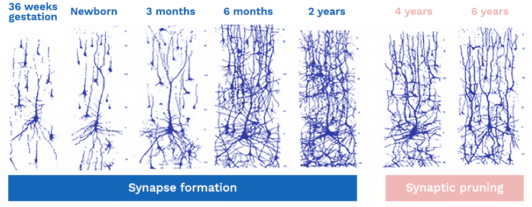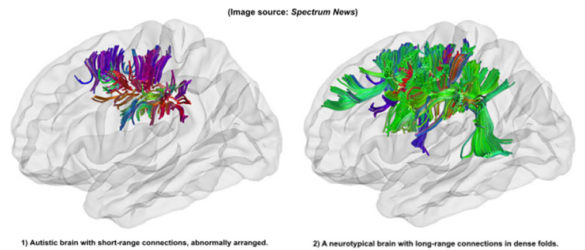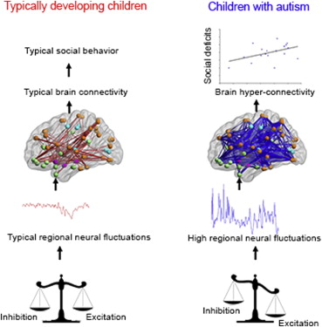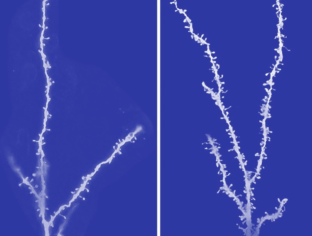What is Autism?
Autism is a complicated brain or neurodevelopmental disorder clinically characterized by impairments in:
1) Language and communication
2) Social interactions and engagement
3) Limited imagination in connection with restricted thinking, behaviours, interests, activities and repetitive and stereotypical motor movements
4) Various cognitive deficits.
DSM-V Autism Diagnostic Criteria (2013)
Autism is the most genetically linked developmental disorder, caused by both inheritable and de novo (spontaneous mutations) gene variations (Leisman, Gerry et.al, 2017). These genetic markers consequently determine the abnormalities in brain development, structure and function that then induce the individual’s specific autistic symptoms.
Brain scans show clear differences in the shape and structure of the brain in autistic versus non-autistic individuals.
Hyperconnectivity in ASD was observed at the whole-brain and subsystems levels, across long- and short-range connections, and was associated with higher levels of fluctuations in regional brain signals. Brain hyperconnectivity predicted symptom severity in ASD, such that children with greater functional connectivity exhibited more severe social deficits (Supekar, Kaustubh, et al., Figure 1).
Why the Range and Degree of Presentation?
Neurophysiological causes

Image source: BioNinja
A synapse is a structure that permits a neuron to pass an electrical or chemical signal to another neuron, allowing information to be exchanged between neurons. During normal brain development, from birth until approximately 3 years old, synaptic overgrowth or a burst of synapse formation occurs- a process where many synapses develop on the brain’s neurons, especially in the cortex. The extent of interconnectivity of the brain depends on the number of synapses that connect neurons. Synaptic density in the prefrontal cortex usually reaches its peak during the third year of life, up to 200% more dense than its adult level. However, after this overgrowth period until adulthood, synaptic pruning gradually transpires- an elegant process of selectively breaking down synapses that aren’t being used enough- and by late adolescence, the “density of neurons drops to about half in the neurotypical brain, whereas it drops only about 16% in autistic brains” (Silvertant, “Autism & Disorganized Thoughts”).
Neurons from people with autism do not undergo the usual pruning rates during childhood and adolescence. Thus, the synaptic overgrowth from early life largely remains. The images show representative neurons from unaffected brains (left) and brains from autistic patients (right); the spines on the neurons indicate the location of synapses.
When less synaptic pruning takes place, a lot of superfluous connections remain intact, and the neurological network is not optimized through the typical learning process that functionally makes the brain more efficient. Since the cortex is involved in many autistic behaviors or abilities, a lack of synaptic pruning in this area will affect the extent of stereotypical patterns. To elaborate, a lack of synaptic pruning means that the neurological network is too active in “ineffective” ways, so when certain regions are active, adjacent regions tend to activate unnecessarily. Many of these regions are involved in movement, the processing of sensory information, conversational skills and socializing (Silvertant, “Autism & Disorganized Thoughts”).
“Research also shows increased local connectivity and regional coherence in some brain regions, which may be a result of overcompensation for reduced long-range connectivity observed in autistic brains (see top image from Spectrum News). In other words, there is increased activity on a local level, but a decrease in overall coherence of brain functioning. This may cause people with autism to focus extensively on details, often distracting them from the bigger picture” (Silvertant, “Autism & Disorganized Thoughts”).
REFERENCES
“Ami Klin, Ph.D. – Imagining a Better World for Children with Autism.” YouTube, uploaded by Brain & Behavior Research Foundation, 18 Jan. 2019,
www.youtube.com/watch?v=UBfeE8YWp3o, Accessed 25 Feb. 2019.
Bennie, Maureen. “Definition of Autism.” Autism Awareness Centre Inc., edited by Maureen Bennie, Autism Awareness Centre, 2021,
autismawarenesscentre.com/definition-autism/. Accessed 5 Nov. 2021.
“Brain Study Finds Evidence that Autism Involves Too Many Synapses.” Autism Speaks’ Science Digest. 21 Aug. 2014,
www.autismspeaks.org/science-news/brain-study-finds-evidence-autism-involves-too-many-synapses. Accessed 25 Feb. 2019.
“Children With Autism Have Extra Synapses in Brain.” PsyPost. 21 Aug. 2014,
www.psypost.org/2014/08/childrenautism-extra-synapses-brain-27527.
Accessed 25 Feb. 2019.
Columbia University Medical Center. “Children With Autism Have Extra Synapses in Brain.” Medical Xpress. 21 Aug. 2014.
medicalxpress.com/news/2014-08-children-autismextra-synapses-brain.html. Accessed 25 Feb. 2019.
Columbia University Medical Center. “Excess Synapses Found in Brains of People with Autism.” YouTube, uploaded by Vagelos College of Physicians & Surgeons, Columbia, 21 Aug. 2014,
www.youtube.com/watch?v=cWIvZR3YI44.
Definition of Autism Spectrum Disorder: NINDS, Publication date September 2015. “Autism Spectrum Disorder Fact Sheet”
Silvertant, Martin. “Autism and Disorganized Thoughts.” Embrace Autism, Martin Silvertant, 20 Nov. 2020,
embrace-autism.com/autism-and-disorganized-thoughts/#Disclaimer. Accessed 11 Nov. 2021.
Supekar, Kaustubh, et al. “Brain Hyperconnectivity in Children with Autism and Its Links to Social Deficits.” Cell Reports, vol. 5, no. 3, Nov. 2013, pp.738-47,
https://doi.org/10.1016/j.celrep.2013.10.001.
“Wendy Chung and Autism: Could Genetics Hold the Answers?” YouTube, uploaded by The Mind Science Foundation, 26 Dec. 2018,
www.youtube.com/watch?v=4vvUegHixhY. Accessed 25 Feb. 2019.
Wright, Jessica. “Tightly Folded Autism Brain Tied to Dense Neural Connections.” Spectrum, 2 June 2016. Spectrum News,
www.spectrumnews.org/news/tightly-folded-autism-brain-tied-to-dense-neural-connections/. Accessed 9 Nov. 2021.
Copyright 2021 © Joanna Brown Babich
Disclaimer: Although the content is well-researched, referenced and sometimes based on professional and personal experience, it does not constitute medical advice.
technical support AndreyBabich.com


